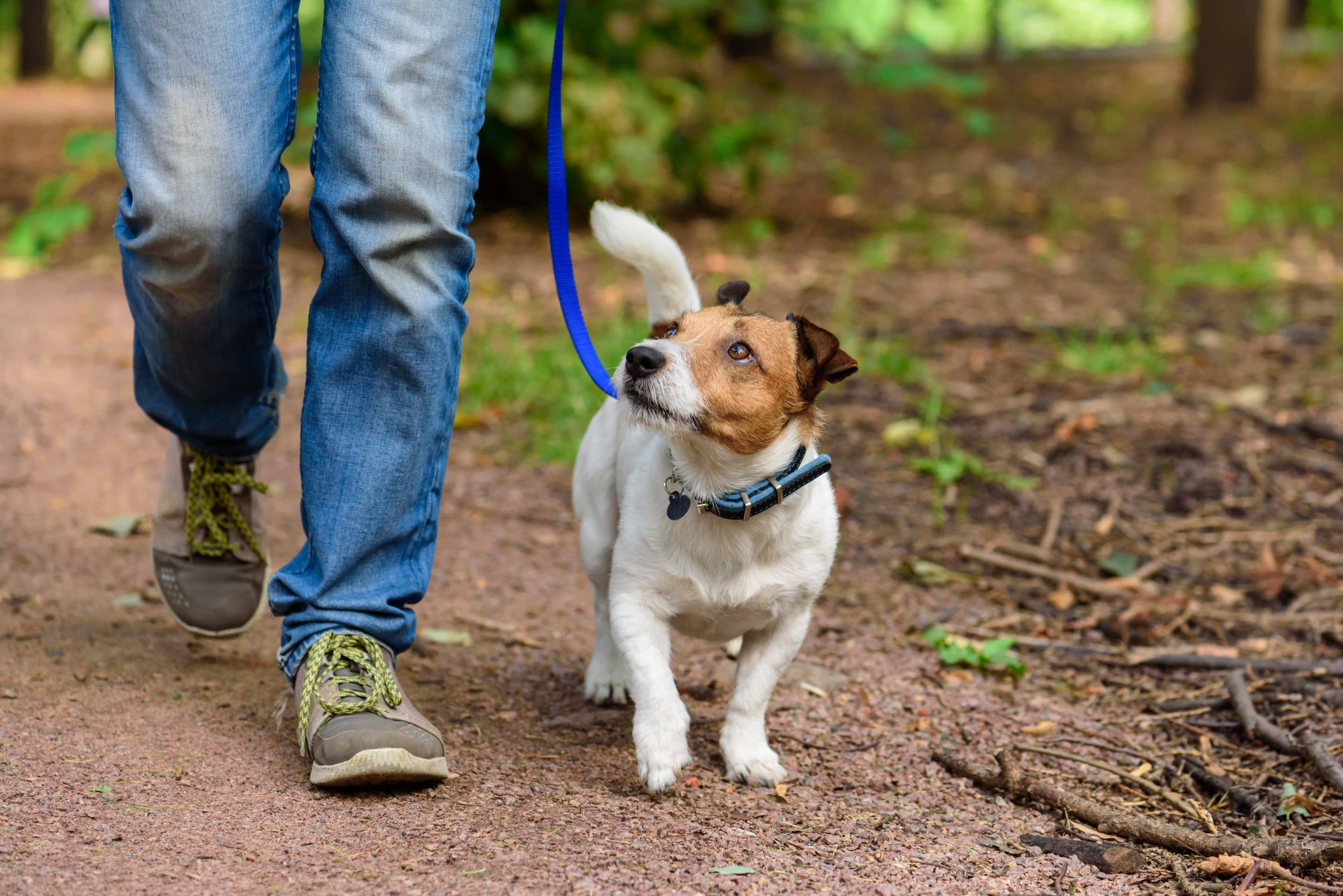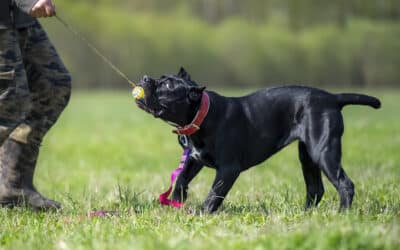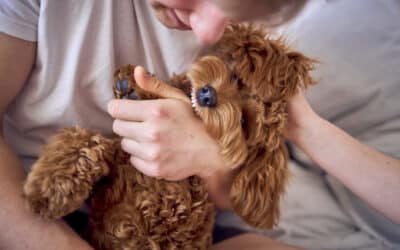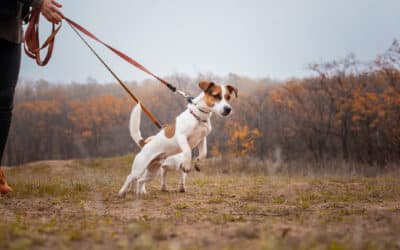Puppies love just about everything, especially their walks! Going outside is a big adventure for a puppy. Naturally, they’re curious about the world, all the sights, smells, and sounds make them eager to see as much as possible. This can lead to leash pulling, which makes walks less fun for you and your dog.
Do you know why puppies pull on the leash? Their natural pace is running, rather than walking like us. They’re inclined to dash from one exciting thing to the next, soaking up as much information as they can with those super-powerful noses.
When we want our puppy to slow down and walk at our pace, they can get frustrated. They might bark, bite their leash, or just insist on pulling more.
So, how do we teach a puppy to walk well on a leash? By making it fun! When we teach our dogs that staying by our side is the most rewarding thing to do, they’ll want to keep up with our pace rather than run full speed ahead.
As part of our puppy training program, OneMind Dogs implements the following tips to help new owners teach their four-legged friend how to walk on a leash like a pro.
Focus on making eye contact
Eye contact is a sign that your dog is tuned in. They’re listening and ready to follow your commands. Well-trained dogs will use eye contact during walks to check in with their owners and make sure they’re doing what they’re supposed to.
Eye contact is all about establishing healthy communication with your puppy. Instead of trying to fight against a pulling pup, wait until the focus is where it belongs — on you.
When puppies make eye contact on a walk, they naturally slow down a bit more. This is precisely what we want to reward them for doing! Make sure you bring plenty of treats along your walk so you can establish a positive connection between eye contact and rewards.
When starting to train eye contact make sure you are in a quiet area with few distractions. As you and your puppy learn together you can take it on the road to different areas and add in more distractions.
Practicing inside is just as important as practicing outside. Leash skills they learn inside can be just as helpful on walks!
Whenever you give your pup a command, make sure they’re looking at you. Praise them for responding, so they start to learn that this is what you want them to do.
Teach them their name
Puppies are more likely to respond to happy, positive voices. But does this mean they’re really listening to you? Not all the time.
Teaching a puppy its name establishes a vocal cue you can always use to get their attention. This can make it easier to achieve that much-needed eye contact on walks.
Whenever your dog is about to pull or starts to tug on the leash, calling their name is a great way to redirect their attention back to you.
Here are some great tips on how to teach a puppy its name:
- Only say their name once in a calm, neutral voice.; praise them when they respond by looking at you.
- Practice saying their name at least 10 times a day — repetition and consistency are everything
- Start from a small distance (around 2 feet), then increase as they get familiar with their name
- Reward your puppy immediately when they look at you to reinforce the connection
- Use treats, play, and verbal praise to positively reinforce their response
Pro tip: Avoid repeating your puppy’s name multiple times — “Stella, Stella, Stella Stella”. This can lead to confusion, and your dog may expect you to call them rapidly like this all the time in the future.
Make training fun
You always want to be the most rewarding thing in the room to your dog. For a lot of owners, this is easier done inside when pups have a lot fewer distractions. Some things puppies find rewarding are: treats, praise, playing, and a big smile. When you know what rewards your dog likes best you can use them to help you incentivize your dog more during training, even when they’re outside and ready for action!
When you’re teaching a puppy how to walk on a leash, it’s important to still let them explore. Tugging them away from every sight or smell that captures their attention can make them more resistant to your commands in the future. It is important that your puppy has a verbal cue that lets them know that it is time to walk nicely and a cue for when it is time to sniff. This will help ensure the puppy does not get confused.
Make sure you choose a leash that gives your puppy enough room to move freely, even if that’s a few steps away from your side.
Appreciate the little things your puppy does, and let them help you discover new parts of the world through their eyes. Learning to see things through your dog’s perspective isn’t just fun, it’s also fundamental to successful training. When you realize why some things are interesting to them, it’s easier to understand your dog’s behavior.
Teach them patience
Puppies have a lot of amazing qualities, but patience usually isn’t one of them. Imagine you’re dealing with a 2-year-old at a toy store. That’s what life is like for a puppy! They want to engage with everything, and they can get demanding with barks and whimpers if they’re made to wait.
While it may be easier to give into their every whim, consider holding back. Puppies that learn patience become much more laid-back dogs who are easier to train.
Patience helps establish trust between you and your puppy, too. They learn that by following your command to “wait”, good things happen. They’ll rely on you to direct their routine, rather than thinking they need to take everything into their own paws.
One way to start teaching a puppy to be patient is by teaching them to sit and wait for rewards. You can do this before you go outside, before feeding them, or by throwing a toy and making them wait to retrieve it.
It takes time, naturally, to teach your puppy patience, but the effort is worth it. You’ll wind up with a happier dog who is more responsive to your commands.
When it comes to leash training, patient puppies are a lot more likely to happily stroll along at their owners’ pace.
Use lots of rewards
The number-one goal when leash training a puppy is making sure they find it fun and rewarding to stay near you! If you teach your dog that staying by your side comes with plenty of rewards, they’ll be more likely to follow suit.
This can be a challenge at first, especially when you’re in an exciting environment. We suggest starting your leash training inside, so puppies aren’t so readily distracted by everything outdoors.
Remember that you should only reward your puppy for wanted behavior. Don’t use treats to make them listen. This can backfire, because they’ll associate the reward with the action you were trying to distract them from.
Imagine accidentally praising your puppy for pulling on the leash!
Positive reinforcement is key to leash training (and all other types of puppy training!). Start slow, and work on praising your pup whenever they take a few steps without tugging. If they are persistent in pulling ahead, stop completely. Call their name, wait for them to make eye contact, and reward them.
Repeat this process as you get your dog more comfortable walking beside you. They should only get a treat when they’re walking well and the leash is slack.
If you aren’t sure what types of treats to give your puppy, try a few and see what they like! Chicken usually goes over well with dogs, and it’s a great high-value treat that you can reserve solely for training.
Be consistent
Do you know the best quality any dog owner can have in training? It’s consistency! Puppies thrive off repetition, just like children learning new skills. You have to help your pup master their obedience training by practicing often.
If you let your puppy pull sometimes, and not other times, they will become confused.
In reality, puppies are not born knowing what we want them to do, so we have to show them what we want. This comes through rewards like treats, play, pets, and verbal affirmations when they offer the behavior we want to see.
The more rewarding you make leash training, the more your puppy will want to stay by your side!

To learn more about leash training your puppy, especially if they are prone to pulling on the leash, fill out the form below and check out our webinar on the 5 easy steps to stop pulling on a leash.



